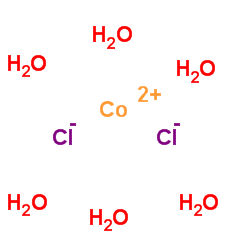Cobalt(II)chloridehexahydrate

Cobalt(II)chloridehexahydrate structure
|
Common Name | Cobalt(II)chloridehexahydrate | ||
|---|---|---|---|---|
| CAS Number | 7791-13-1 | Molecular Weight | 237.931 | |
| Density | 3.35 | Boiling Point | 1049 °C | |
| Molecular Formula | H12Cl2CoO6 | Melting Point | 86 °C | |
| MSDS | Chinese USA | Flash Point | N/A | |
| Symbol |



GHS07, GHS08, GHS09 |
Signal Word | Danger | |
| Name | cobalt chloride hexahydrate |
|---|---|
| Synonym | More Synonyms |
| Density | 3.35 |
|---|---|
| Boiling Point | 1049 °C |
| Melting Point | 86 °C |
| Molecular Formula | H12Cl2CoO6 |
| Molecular Weight | 237.931 |
| Exact Mass | 236.934296 |
| PSA | 55.38000 |
| Vapour Pressure | 40 mm Hg ( 0 °C) |
| InChIKey | GFHNAMRJFCEERV-UHFFFAOYSA-L |
| SMILES | O.O.O.O.O.O.[Cl-].[Cl-].[Co+2] |
CHEMICAL IDENTIFICATION
HEALTH HAZARD DATAACUTE TOXICITY DATA
MUTATION DATA
|
| Symbol |



GHS07, GHS08, GHS09 |
|---|---|
| Signal Word | Danger |
| Hazard Statements | H302-H317-H334-H341-H350i-H360F-H410 |
| Precautionary Statements | P201-P261-P273-P280-P284-P304 + P340 |
| Personal Protective Equipment | Eyeshields;Faceshields;full-face particle respirator type N100 (US);Gloves;respirator cartridge type N100 (US);type P1 (EN143) respirator filter;type P3 (EN 143) respirator cartridges |
| Hazard Codes | T:Toxic |
| Risk Phrases | R22;R42/43;R49;R50/53 |
| Safety Phrases | S53-S22-S45-S60-S61 |
| RIDADR | UN 3260 8/PG 2 |
| WGK Germany | 2 |
| RTECS | GG0200000 |
| Packaging Group | III |
| Hazard Class | 9.0 |
| HS Code | 28273400 |
| HS Code | 28273400 |
|---|
|
Nematic liquid crystals confined in microcapillaries for imaging phenomena at liquid-liquid interfaces.
Soft Matter 11 , 6999-7004, (2015) Here, we report the development of an experimental system based on liquid crystals (LCs) confined in microcapillaries for imaging interfacial phenomena. The inner surfaces of the microcapillaries were... |
|
|
Human epidermal growth factor receptor-2 antibodies enhance the specificity and anticancer activity of light-sensitive doxorubicin-labeled liposomes.
Biomaterials 57 , 1-11, (2015) Antibody-mediated targeting therapy has been successful in treating patients with cancers by improving the specificity and clinical efficacy. In this study, we developed a human epidermal growth facto... |
|
|
Highly sensitive SERS-based immunoassay of aflatoxin B1 using silica-encapsulated hollow gold nanoparticles.
J. Hazard. Mater. 285 , 11-7, (2015) Aflatoxin B1 (AFB1) is a well-known carcinogenic contaminant in foods. It is classified as an extremely hazardous compound because of its potential toxicity to the human nervous system. AFB1 has also ... |
| Dichlorocobalt hexahydrate |
| MFCD00149652 |
| Cobalt chloride hexa |
| CobaltousChlorideAr |
| CobaltChloride6H2OAcs |
| COBALTOUS CHLORIDE 6H2O |
| COBALT CHLORIDE PURPUREO |
| Cobalt chloride hexahydrate |
| COBALTOUS CHLORIDE |
| EINECS 231-589-4 |
| Cobalt chlordie |
| COBALT CHLORIDE,ACS |
| Cobalt(2+) chloride hydrate (1:2:6) |
| chlorekcobaltawy |
| Cobalt(II)chloridehexahydrate |
